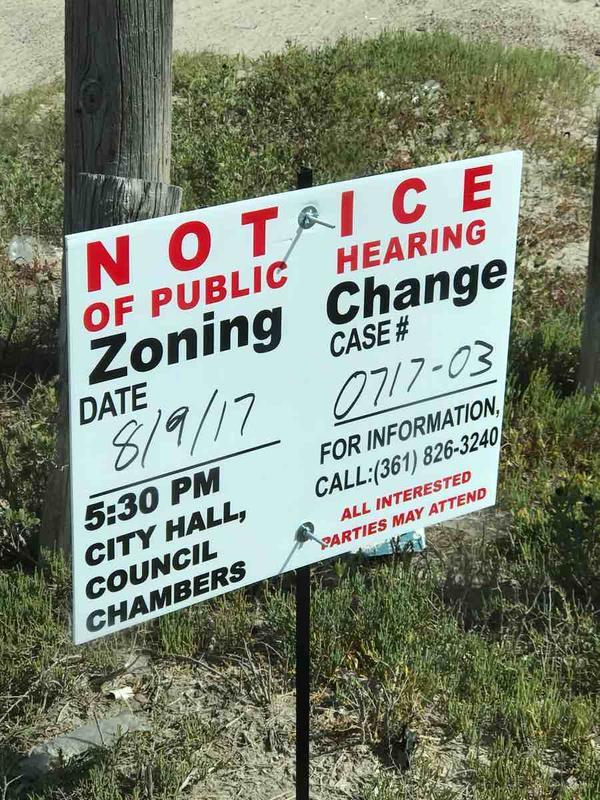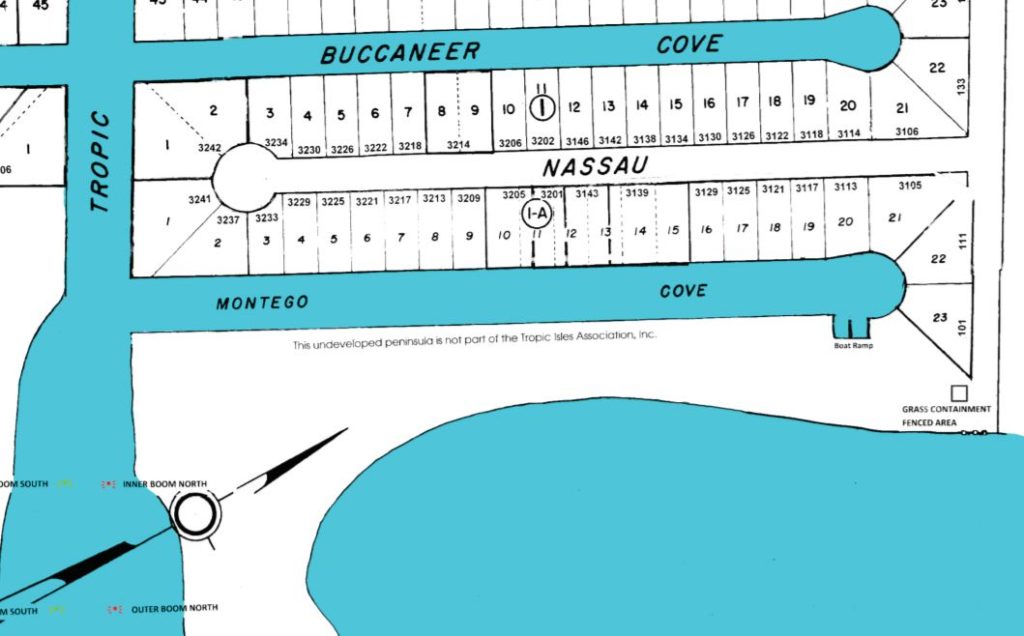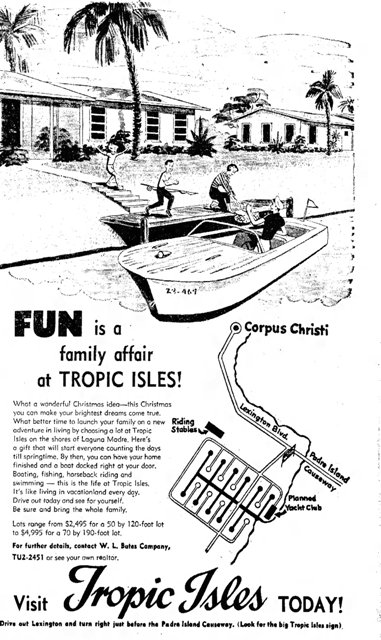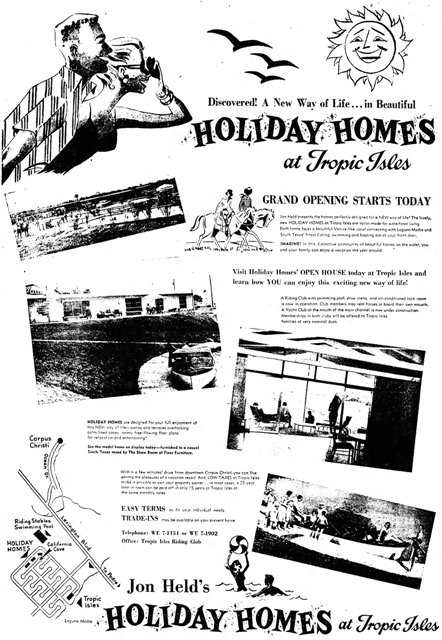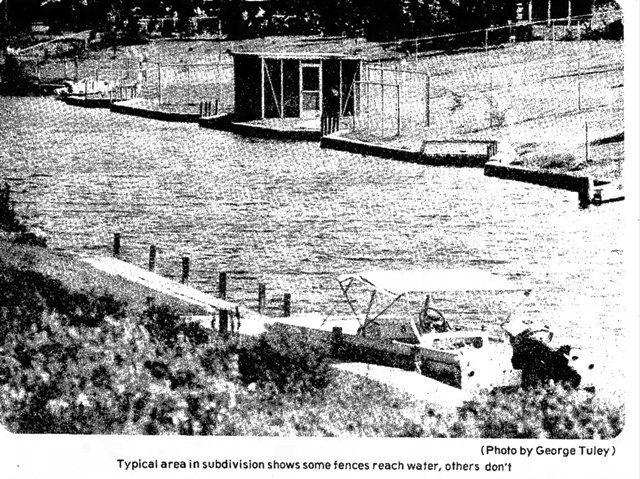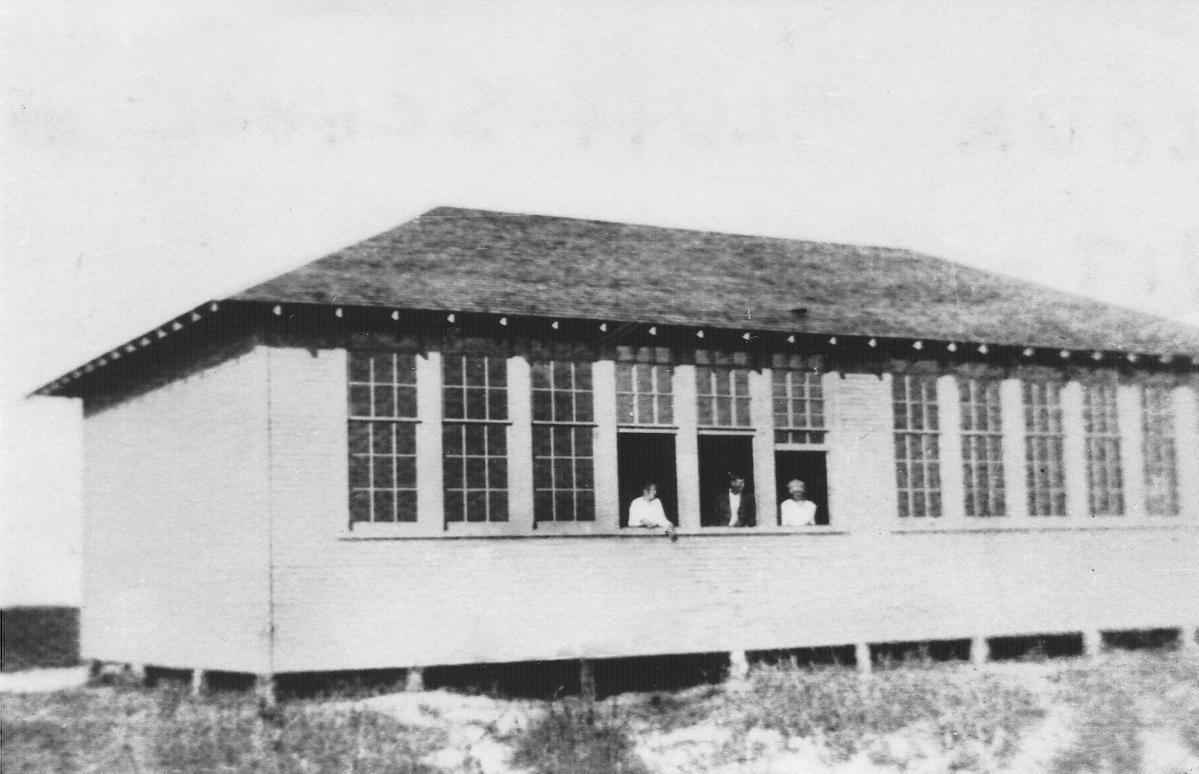[spacer height=”20px”]
In light of the recent concerns by Flour Bluff residents over a proposed RV park on the edge of the Tropic Isles subdivision, it seems appropriate to address an area of Flour Bluff that helped change the way outsiders saw the little fishing village. Currently, a company out of Austin is attempting to have a piece of property at the end of Caribbean along the Laguna Madre rezoned to accommodate the creation of a 60 unit RV park and marina. Many of the property owners near the almost 8-acre peninsula are concerned about what it might bring to their neighborhood. Tropic Isles has had an active HOA since 1971 and a building committee since 1956, started to ensure that which was set up to assure that there would be no sub-standard building in the development when the subdivision was created. However, the property in question is not controlled by the Tropic Isles HOA, at least not according to the association’s map pictured below.
[spacer height=”20px”]
[spacer height=”20px”]
On April 16, 1956, Tropic Isles in Flour Bluff made the Corpus Christi Caller-Times for the first time. According to the article, this new, multi-million dollar housing project would provide a boat landing for each of 400 residential lots. The development, fashioned after the street-channels of Ft. Lauderdale, Florida, was the work of the W. L. Bates Co. and the Edwin Flato Co. and had one main boat channel, tying in with the Intracoastal Canal and other main waterways (Humble and Arkansas fuel channels) in the Laguna Madre, and 10 access channels running off the main one, giving each lot access water access. Lots sold from $1995 to $5000. Potential buyers could put $15 down and pay $30 a month to own waterfront property in this Venice on the Laguna Madre. 525,000 yards of dirt were dug out of the channels at a cost of around a half-million dollars. Lot owners built their own homes in accordance with the guidelines established by the building committee. Tropic Isles formally opened on December 9, 1956, and the little peninsula that might soon be lined with tiny homes for winter Texans was to be the site of the Tropic Isles Yacht Club.
[spacer height=”20px”]
[spacer height=”20px”]
This subdivision was peddled to veterans and active military or civil service who worked at NAS Corpus Christi. When Bob Flato presented the plat to the Nueces County Commissioners Court in 1956, he assured them, according to an April 27 Caller-Times article “that adequate paved streets would be built, a bridge would be built where proposed boat channels would cut county roads, would provide adequate building restrictions, and would provide for cooperative maintenance of the boat channels by persons who buy the subdivision lots.” On the day Tropic Isles opened, W. L. Bates, who developed the tract for Edwin Flato Co., described it as “a new concept for living in South Texas” as he invited the public to visit the area. “We urge you to come and see the real resort living which will be available to a buyer of this property,” said Bates. They went on to list the features of the area, which included:
- boating and fishing done from the backyard of a home;
- duck hunting in the Laguna Madre;
- horseback riding at riding stables already in operation nearby;
- swimming and other activities at the proposed Tropic Isles Yacht Club; and
- visiting the nearby Padre Island and Mustang Island beaches.
“All of this will be available only 20 or 25 minutes from downtown Corpus Christi by car,” pointed out Bates as he described the layout of the development on Laguna Shores Road, two and a half miles from the Padre Island Causeway. Jon Held, Flour Bluff resident and local home builder, had two model houses already under construction for all to see that day. There were no restrictions on the price of a home, but certain exterior appearance requirements were enforced by the architectural committee. All the streets were named with a “tropical flavor”, and 780 palm trees were planted in the area. The utilities available included water, natural gas, electricity, and telephone service. Furthermore, it was pointed out, the “taxes will be noticeably lower” since Tropic Isles was outside of the Corpus Christi city limits. The local developers knew if they built it, the people would come.
[spacer height=”20px”]
[spacer height=”20px”]
There was nothing else like it in Corpus Christi or the surrounding areas, so come they did. For a while, the new homeowners adhered to the building regulations set by the committee, at least until May of 1969. Then, seventeen Tropic Isles residents filed suit opposing the building of a house they considered substandard. Rufus Thomas and Donald Carbonneau had moved the house onto a lot and started working on it without permission from the development committee, which set a few folks on edge. It appeared that trouble had come to Paradise.
Then, in 1974, a squabble broke out over a fence blocking a canal walkway. According to the January 23 Caller-Times article, Robert Stromstedt and Benjamin Inman who lived on Caribbean had built the fences to protect their boats tied up along the bulkhead. Michael Padrezas, the director of the Tropic Isles Association, objected to the fences, claiming they were illegally erected, blocked the walkway, created a problem for firefighters to get to a boat if it was on fire, and posed a hazard to children who played along the walkway. In a show of authority, he climbed around one and walked along the bulkhead, which prompted Stromstedt and Inman to file trespassing charges against Padrezas. This landed the case in Mrs. Hawley’s Pct. 8 court in Flour Bluff. Another Tropic Isles resident, Terry Cornell, evidently accompanied Padrezas on the walk along the bulkhead, but he was not named in the complaint. Mrs. Hawley said she could not act until proof of ownership of the walkway could be determined, which was not determined until August 30, 1976. The Court of Civil Appeals of Texas, Corpus Christi, records state: “The trial court rendered judgment that the property in question was part of a public easement granted to the public and that defendants are therefore perpetually enjoined and restrained from obstructing or interfering in any manner the free passage and use by the public on said property. The trial court ordered appellant Inman to remove the fences or any obstruction then erected on the property.”
[spacer height=”20px”]
[spacer height=”20px”]
Even as recently as 2008, the property where the RV park is planned came into question. According to the TIHOA, “On Sunday, June 8, 2008, Tropic Isles Association received verbal notification that the open access to the boat ramp at Caribbean will be discontinued, and it will be blocked off. After speaking with Roger Viar at that time, the Manager for the owner of the properties, they closed access to the ramp and area due to their liability concerns. In lieu of the use of the boat ramp at Caribbean, they provided access to Tropic Isles Association Members to launch boats at Bluff’s Landing Marina & Lodge for a period of time, but it has since been discontinued. Members will now have to pay for their launches or use the free ramps on the island.”
This same piece of property will come before the Corpus Christi Planning Commission on August 9, 2017, as the new owners seek to have it rezoned for an RV park. Some residents believe it will create an eyesore and a hindrance to the homeowners who live near it. Others feel if the owners show they are responsible by controlling the clientele, performing regular maintenance and upkeep, and working to add to the fishing village ambiance that exists in the area, then it can be a welcome addition to Tropic Isles and to Flour Bluff, the little town that almost was.
[spacer height=”20px”]
[spacer height=”20px”]
